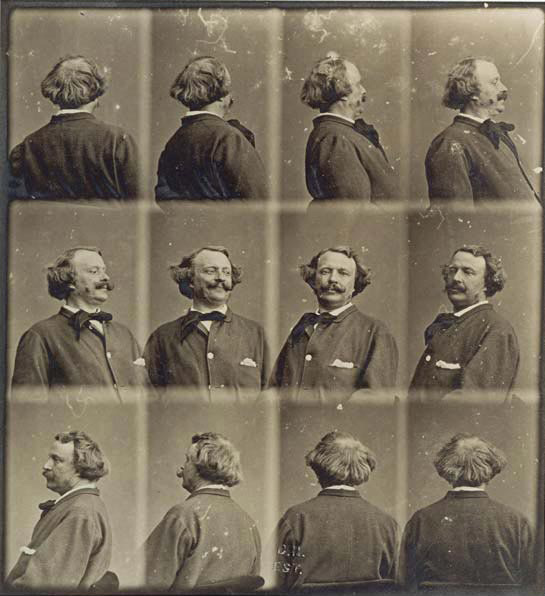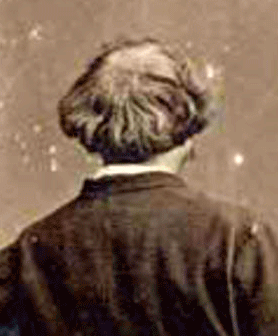Today’s post is about Nadar, the great French photographer and certainly one of the most interesting people I’ve come across.
Nadar was born Gaspard-Félix Tournachon in Paris in April of 1820 to middle-class parents. His father was a publisher and bookseller, but not a very successful one. Victor Tournachon went broke in 1833 and died a few years later, when his son was 17 years old.
Initially, young Gaspard-Félix was interested in becoming a doctor, particularly the emerging field of psychology. He was a bright student – but after his father’s death, he left school and joined the bohemian life in the poorer quarters of the city. It was there that Nadar acquired the nickname that he is known by today. The young man had a curious habit of adding “dar” to the end of some words, just to make them longer (loquaciousdar?). This vocal tic delighted his friends, who dubbed him Tournachon-dar. Later this was shortened to Tournadar, and finally evolved to its final form: Nadar.

Nadar, self portrait circa 1860 (b/w photo; self portrait; auto portrait); Archives Charmet
After a lackluster attempt at journalism, Nadar forayed into novel-writing, which also turned out to be a disappointment. Nadar had a gift for not being crushed by his failures; they rolled off of him harmlessly, like drops of water. He turned to his next career choice and this time he met his first professional success in drawing caricatures. He was fiercely critical of Louis-Napoléon, nephew of Napoléon Bonaparte, who would eventually become the emperor. An emperor who disliked a critical press, no less. One of Louis-Napoléon’s first actions was to ban political caricature.
Now in his early 30s and finding his newly-discovered success coming to a premature end, Nadar developed a plan. His brother Adrien was interested in photography, and Nadar decided to open a photography studio. Nadar planned to be minimally involved – he would spend the majority of his time drawing. The studio opened in 1854 but then the brothers’ path took an unexpected turn. Adrien was bored by photography and soon drifted away – but Nadar discovered a genuine aptitude for portraits within himself. His work quickly caught the attention of Paris. Nadar was an avid hot air balloonist and in 1858, he took his camera with him on a flight that produced the world’s first aerial photographs. Three years later, Nadar took the world’s first underground photographs, in the Parisian catacombs.

Nadar’s photograph of the Impressionist painter, Claude Monet (Nadar: Bettmann: CORBIS)
Nadar was a gifted photographer who believed each photograph should be treated as a work of art and the famous people of the day flocked to his studios to be immortalized. Nadar had a strong preference for natural lighting and simplicity. A visitor to 35 Boulevard des Capucines might bump into genius or glitterati in the person of Sarah Bernhardt, Franz Liszt, George Sand, Jean-François Millet, Honoré Daumier, or Charles Baudelaire.
Nadar’s passion for photography did not interfere with his lifelong love of ballooning. In 1863, the famous photographer commissioned the prominent balloonist Eugène Godard to construct an enormous balloon, 196 feet high and with a capacity of 210,000 cubic feet. Nadar named it “Le Géant” (The Giant), which inspired Jules Verne to write Five Weeks in a Balloon and From the Earth to the Moon.

A series of twelve self-portraits, made in 1865.
Nadar later became the president of the Society for the Encouragement of Aerial Locomotion by Means of Heavier than Air Machines.
And in 1870, during the Siege of Paris, Nadar helped to establish the world’s first airmail service, when he helped organize balloon flights to carry mail into the city.
In 1886, Nadar photographed Franz Liszt, just three months before the composer’s death. Liszt’s photograph is the featured image of this post.
The same year, Nadar chose famed French chemist Michel Eugene Chevreul (Aug 31, 1786 – Apr 9, 1889) to be the subject of another first. It was called a photo interview, and was published in Le Journal Illustré. Today, thanks to the magic of YouTube, you can watch it like a slow motion video. Chevreul is 100 years old in these images!
In 1900, at the age of 80, Nadar published Quand j’étais photographe, in which he described the second, near-fatal flight of Le Géant. It took 115 years, but this book was translated into English in 2015 with the title When I was a Photographer.

Nadar had a knack for publicity, among other things, as seen in this 1864 self-portrait-as-balloonist photograph, modestly titled Prophetic Hero Aloft (Nadar did not have a knack for humility)
Nadar died on March 20, 1910 at the grand age of 89. He is buried in Père Lachaise Cemetery in Paris.
The poet Charles Baudelaire was a close friend of Nadar and known to muse about his friends in his journals. In considering the great photographer, Baudelaire penned a short, perfect description: “Nadar, the most astonishing expression of vitality!”

Someone converted the 12 self-portraits into a gif – an innovation Nadar would probably love!
Pingback: The Twenty-One Balloons by William Pène du Bois – Once Upon a Homeschooler